Most metallurgists appreciate the great need of a process for the extraction and recovery of valuable metals from complex ore, where the presence of one metal increases the cost of extracting the other metals to such an extent that not any of the metals can be extracted at a profit. We need only refer to some of the mines in Colorado, Utah, and New Mexico, where oxidation has taken place and the sulphur, zinc, copper, and some of the iron and other metals have been leached out, large bodies of oxidized ore remaining, rich in lead, silver, and sometimes gold. These metals have been concentrated by the removal of the other metals, leaving a very desirable ore for treatment in the blast-furnace for the production of lead bullion, and recovery of the silver and gold. If lead is not present, the gold and silver are usually recovered by some method of milling, or the ore is shipped to a smelter, where it is mixed with lead ore or copper- iron sulphide ore from some other mine. In these same mines, when developed to greater depth below the leached or oxidized zone, the ore is found to contain the original mixture of sulphur, zinc, copper, etc., added to, or I should say left with, the lead, silver, and gold values; but instead of adding to the value of the ore, the presence of these elements, especially zinc, makes the copper, silver, and gold of less value, and often worthless. Such was the experience of the oldest mines in Leadville, Colo., until methods of mechanical separation of the lead from the zinc were developed sufficiently to allow of some profit by the making of a concentrate rich in zinc to be shipped to the zinc smelter, and sometimes a lead concentrate which could be shipped to the lead smelter; but even in these cases the waste of the different metals is a very serious matter. In the very best concentrating plants some zinc will be left in the lead concentrate, to be lost and to give considerable trouble in the lead-smelting furnace. On the other hand, some of the lead, with a large percentage of the copper and silver, will follow the zinc into the zinc concentrate, to be perhaps, recovered by smelting the cinder or clinker left in the retorts after volatilizing the zinc for the production of spelter. The losses of copper and gold in this case are not so great, but the cost of smelting this residue is often greater than the combined values of the gold, silver, and copper in it. The loss of silver by volatilization is also much greater than the loss of either gold or copper, so that zinc ore rich in silver is not suitable for this process. On the other hand, a sulphide ore containing the same amount of zinc as the above complex ore, with none of the other metals, can be easily concentrated. Often it is a simple matter to make a concentrate containing from 40 to 60%, zinc (as is now being done in the middle Western States) which can be sold to the zinc smelters, who will pay a much higher price per unit for the zinc contents at 60% than at 40%. Any one familiar with metallurgy will appreciate that one reason for this is, that the higher the percentage of a metal in an ore, the higher will be the percentage of recovery obtained.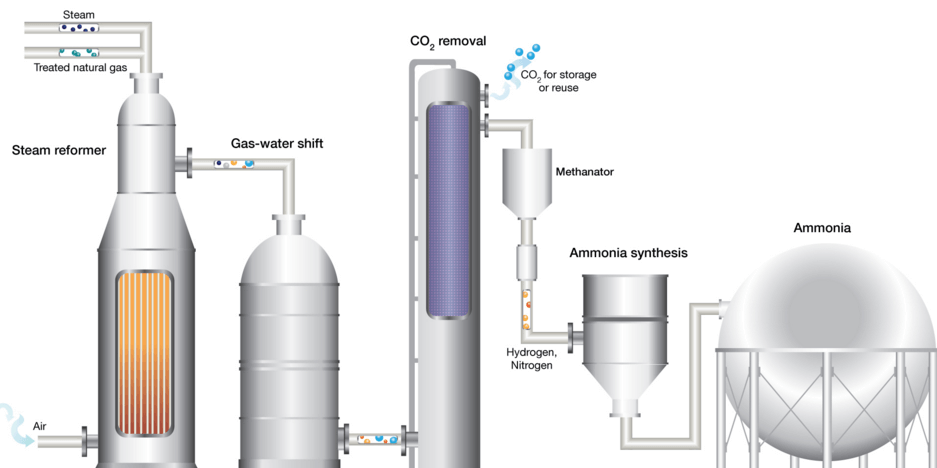
A sulphide copper ore containing, say, 3%, and upward of copper and little or no zinc is very cheaply reduced to a copper matte, if in sufficient quantity and within a reasonable distance of some rail road. The presence of silver and gold is of great benefit in assisting the copper to make profits, for the reason that the freight on precious metals, when shipped with either copper or lead products, is almost negligible. But supposing such ore to contain 14 to 40%, zinc with barium and other impurities, and the structure of the ore not suitable for any mechanical means of concentration; in such cases the zinc content decreases, and sometimes destroys, the value of the copper, while the ore is not rich enough in zinc for the recovery of zinc by any ordinary methods. Such ore as this, containing copper, lead, silver, gold, and zinc, occurs in a number of large mines in California, Colorado, Utah, Nevada, Arizona, and New Mexico, some of which mines are being worked successfully by concentrating the ore into zinc concentrates and lead concentrates, with sometimes a copper concentrate; but the per cent, of loss of the different metals is excessive. There are a great many mines the ore of which cannot be concentrated by any known method. I have had such ore as this in mind for several years, and after investigations I decided to have the ammonia-carbon dioxide process tested and developed. This process is the only one I know of for the treatment of the complex zinc sulphide ores of the Rocky Mountains by which the gold, silver, copper, and lead can be recovered and saved, after first extracting and saving the zinc, thus turning the zinc into an asset instead of a liability, and enabling a great number of mines now idle to become profitable.
There is another view to be taken of this situation: The United States government should and perhaps will insist on all rail road companies and large mining companies treating their timber to prevent decay, except, perhaps, that used for temporary structures; first, to lessen the number of accidents, and second, to stop the unnecessary waste and destruction of timber in the country. This would not be any hardship on either the rail road companies or the mining companies, for, looking at the subject from an economic standpoint, it would be a great benefit to them to have their timbers last from 12 to 20 years, instead of only 2 to 5 years, as is often the case at present. The high price of creosote almost prohibits its use, except perhaps as an outside coating for timber already treated with a cheaper wood preservative, such as zinc chloride. (The question is, could not some cheaper oily substance be used for a surface coating to timbers in wet ground to prevent the leaching out of the zinc chloride?) I have mentioned the use of zinc chloride for wood preservative purposes to show-that there is a demand for zinc in this direction, which will help to solve the problem of marketing the zinc when recovered from the immense quantities of complex zinc ore in the Rocky mountains. At the same time that the zinc is being recovered from such ore, considerable quantities of lead, copper, silver and gold will be added to the world’s supply. In addition to the demand for zinc to be converted into zinc chloride for wood preservative purposes, the use of the metal for roofing, for zinc foil for wrapping tea and other packages, and for the manufacture of brass is constantly growing; as is also the use of zinc oxide for the manufacture of pigments for painters, and in the manufacture of rubber goods.
W. R. Ingalls, in his Metallurgy of Zinc and Cadmium (p. 668, writes:)
“ The merits of zinc white as a pigment were summarized by Maximilian Toch in a paper recently read before the New York Section of the Society of Chemical Industry. He stated that the consumption of white lead is decreasing and that it should not be used alone. The specifications of the United States Lighthouse Department demand a mixture of 75%, of zinc oxide and 25%, of white lead. Zinc white mixes well with other pigments, particularly with white lead. Zinc oxide made directly from ore is more durable than that made by burning spelter.”
The process 1 have in mind for the treatment of the complex zinc ores is briefly as follows: Grind the ore, roast, regrind, leach out zinc with ammonia and carbon dioxide, precipitate from the solution any copper which, has been dissolved with the zinc, and put back in the residue. Smelt the residue for the recovery of copper or lead, with the gold and silver. The ammonia and excess carbon dioxide are distilled from the solution containing the zinc and recovered for further use. As the ammonia is being distilled, the zinc is precipitated as a pure white basic zinc carbonate, filtered out, and then calcined to zinc oxide, or the basic zinc carbonate can be reduced direct to either zinc chloride or spelter. Due to lack of funds, we have not yet installed a large commercial plant at the Afterthought mines, in California, so that at present we only have a 150-lb. capacity plant.
Since writing my last article for the Institute, our metallurgical chemist, P. L. Wilson, has made a number of continuous runs, each of several days duration. The following is a copy of his last report of a 14 days continuous run: (It should be noted that this report is based on a test of our lower-grade zinc ore containing about 20% zinc. The extraction from our ore containing 30 to 36%, zinc is from 85 to 95%).
Here I report results on test No. 65 secured from 12 complete cycles and during a period of 14 days. Two days were required for unavoidable repairs.
Preparation of Ore:
The raw sulphide ore was crushed to 30 mesh (maximum). Its sulphur (soluble) content varied from 18.7 to 20.5%, and averaged 19.7%. A sulphatizing roast was given the ore. The weight of the roasted ore showed a slight increase over the raw ore in several cases, the average weight remaining nearly the same. The roasted ore was wet slimed for 10 hr. in each case. No attempt to classify the product was made. The coarse product remaining on 150 mesh was but little in each case.
Extraction:
Pressure throughout agitation, filtering, leaching, etc., was 30 lb.
Time throughout the cycles was less than 8 hr. average. This time was inclusive of time taken to operate valves, etc.
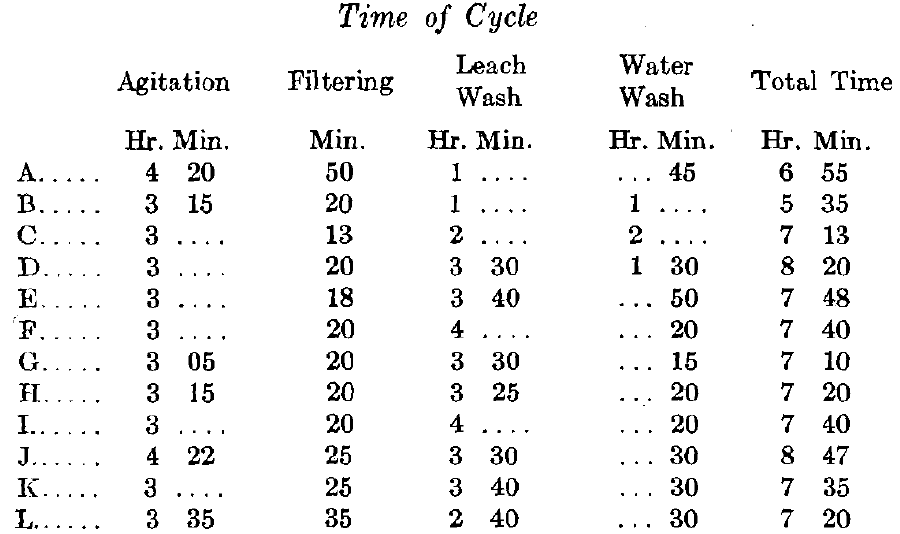
Solution used in agitation was about 4 :1 ore, due to the small charges used. On a 19% zinc ore the filter press in use will handle conveniently the residue of a 30-lb. charge; whereas, with a 25% zinc ore a 40-lb. charge, and 30% zinc ore a 50-lb. charge. This is due to the relative shrinkage in volume of the residue when the zinc is extracted.
Zinc extraction varies from 79.7% on an 18.6% roasted zinc ore to 84.9% on a 20.72% roasted zinc ore.
Copper extraction was not recorded, as the cement copper was filtered with the residue. Silver extraction is negligible, which remains in the residue. The slight extraction is no doubt due to discrepancies in the weights of the net ore and residue.
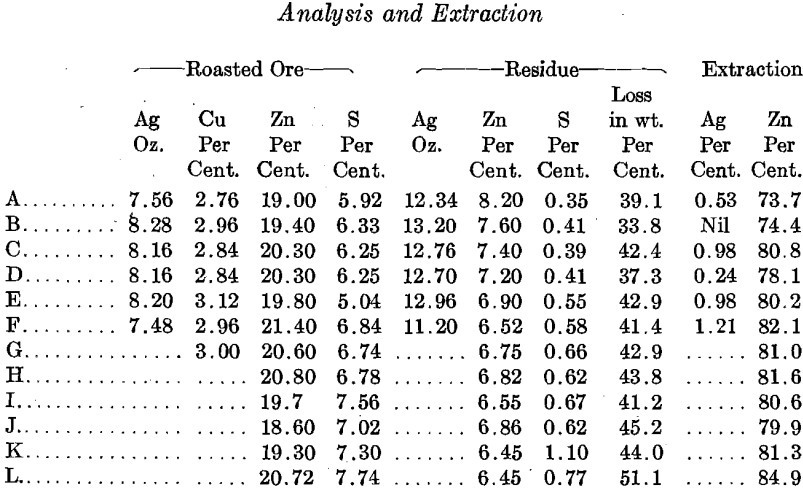
Recovery:
Boiling out with the use of the extra still kept the amount of solution down to a minimum. Live steam was admitted into the third still at intervals to facilitate the boiling out of the zinc. The excess solution was used in washing the residue and saved to grind the ore in.
Zinc precipitate was off color for the most part. The steam from the first still carried over rust and oil enough to discolor. The rust was caused by the filter press and pipes having been idle for some months previous to this test. Also fine rust and ore were carried into the receiving still from the ore filter, Decantation from the copper precipitator was tried, but the rust occurred as before. By refiltering the solution through a finer filter (filter paper placed on the leaves of the press) the resultant zinc carbonate was as white as could be desired. The volatile moisture, etc., contained in the precipitate varied from 65.2% to 78.65. The recovery of the zinc basic carbonate and hydrate was 99.7%. This 0.3%, was left in the solution.
Zinc Recovery:
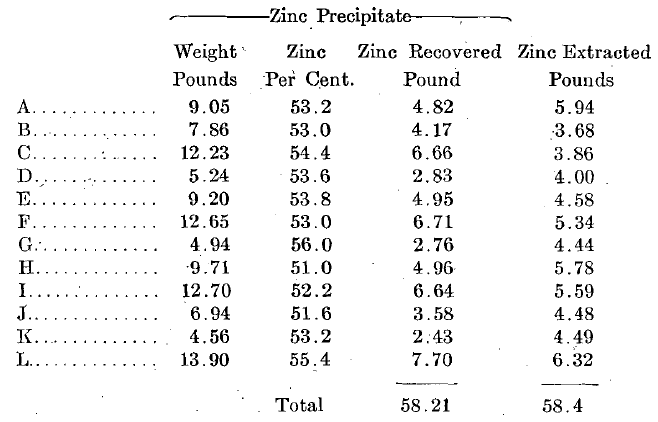
Losses:
Ammonia losses were 4.44%, during the run (not counting A, B, C and D). Of this amount 0.28%, was unaccounted for numerically, but due to intermittent leaks in the system 17% of the total ammonia .was tied up as fixed ammonia. No lime was used to free this in the run. Compressed air was used to drive the charge through the filters and the air remaining in the agitator and copper precipitator was released through a scrubber. In like manner the absorbers and separator were connected with scrubbers. Washing the residue first by hot solution from the first still and then with steam brought the residual ammonia down to from 1.3 lb. to 3 lb. per ton of ore. The zinc precipitates held some back as a salt, there being no smell of volatile ammonia.

Carbon dioxide losses were mostly in the residues as tabulated below. The total loss was 24.72.
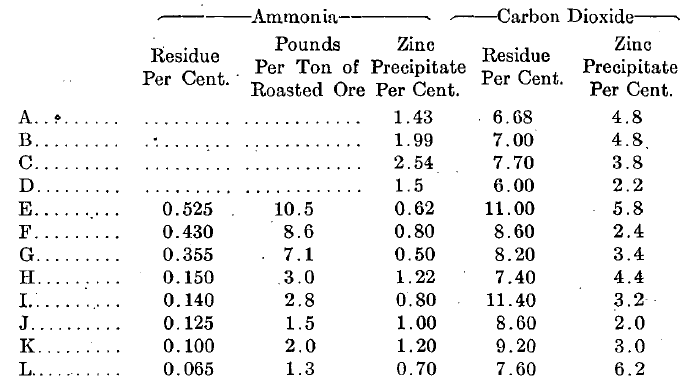
Remarks:
In recovery of the ammonia by boiling out, the ammonia content of the liquor in the absorbers could be controlled at will; 15.3%, ammonia was obtained in one instance in solution to be used again.
